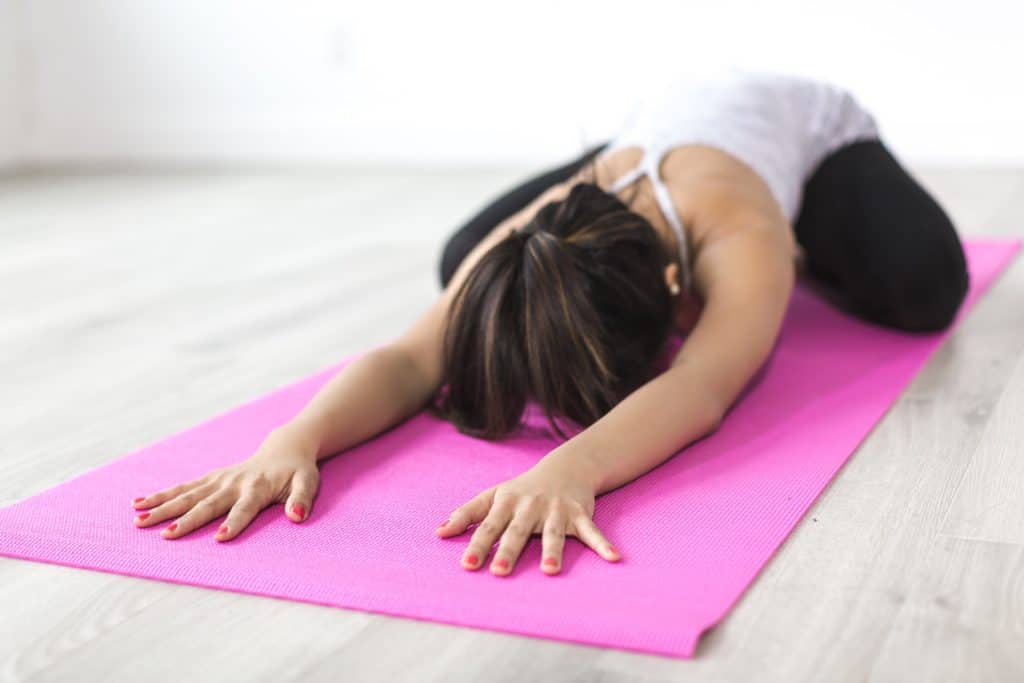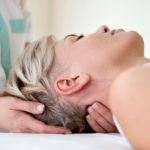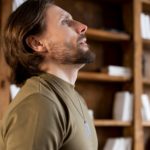
Rachael Cooper
Certified yoga instructor (Vinyasa and Hatha Yoga), CYT 200 teacher training certificate
Back pain is becoming a nuisance. It is so “popular” that it’s one of leading disabilities globally. Our modern lifestyle is what contributes significantly to the causes of back pain.
Yoga has shown to be an effective treatment in alleviating back pain caused by the spine and muscles and also contributes to spinal mobility.
Practicing the yoga asanas improves strength, balance and flexibilty, and today we will learn the 5 poses that even the most stiff beginner can start with.[1]
Know your body - Our spine
Our spine consists of 24 vertebrae, connected by facet joints and stacked in a S shaped curve.
Each vertebrae is separated by discs
The S shape of the spinal column allows weight to be distributed evenly, preventing too much compressive stress on each vertebrae.
The discs work as shock absorbers, allowing our body to bend and twist, while the muscles supporting the spine allow mobility. All three work together to give us structure and support, and to protect our spinal cord.[2]
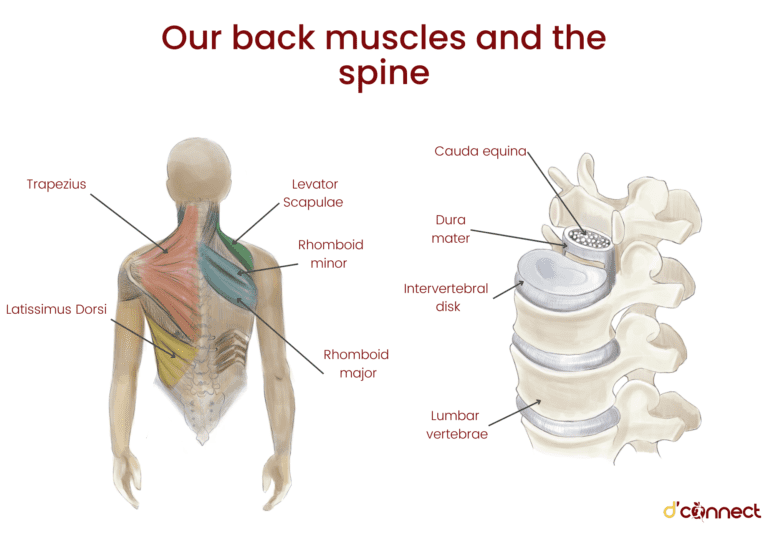
Muscles supporting the spine
The paraspinal muscles are attached to the spine and they support the spine by assisting in holding the load and allowing mobility.[3]
Keeping these muscles strong helps to prevent the spine from injury as well as different conditions and spine disorders.
Paraspinal muscles take on a lot of load and pain, which is commonly caused by sitting for long periods of time, or not using correct posture and alignment in everyday tasks.
RELATED — Have you got poor posture? (18 long-term effects and health risks)
Approximately 80% of adults in their lifetime will experience pain in the lower back muscles. So, let’s stretch and strengthen those muscles.
Poses, exercises and stretches
There are a number of yoga asanas that target the facet joints, promote healthy nutrients to the discs and strengthen the muscles around the spine.[2]
The asanas move the spine in all directions
- flexion
- extension
- lateral flex
- rotation
Each asana targets different areas but when we combine each of them into a regular practice, we learn to train our bodies to be in correct posture and maintain the natural S shaped curve of our spine on a daily basis.[2]
Standing half forward bend - Ardha Uttanasana
Ardha = half, ut = intense, tan = stretch
Adapting the traditional uttanasana (forward fold), into a half lifted version, with the use of something to hold on to, such as a chair or table, can provide a considerable amount of pain relief around the lumbar and cervical spine.
Ardha uttanasana stretches the back muscles
It also opens the small blood vessels to reduce lactic acid build up, which could have been caused by injury in the surrounding areas or exercise.
Research show it’s effectiveness in easing pain caused by the sciatic nerve.[2]
How to do standing half forward bend
To come into ardha uttanasana, place your hands on the chair or table as wide as the shoulder. Then, walk back to fold half way down and bring the thigh bones back away from the hands allowing the sides of the torso to lengthen.

Allow the shoulders to roll outwards, bringing space around the top of the back. Keep some firmness in the core to prevent the lumbar area from collapsing. Turning the toes inwards can help if the sciatic pain is too intense.[4]
Downward Facing Hero - Adho Mukha Virasana
Adho = downward, mukha = face, vira = hero or warrior
This asana is very similar looking to balasana (child’s pose) however it provides more lengthening in the lower spine than balasana does.[5]
Adho mukha virasana lengthens the spine and the muscles similarly to ardha uttanasana but also targets the muscles and joints around the hips which also contribute to back health.[2]
How to do downward facing hero pose
Kneel on the floor and sit with your feet on each side of your thighs. Keep your knees together or spread them out just slightly wider than hip width.
The purpose is for the inner thighs to support the weight of the torso.
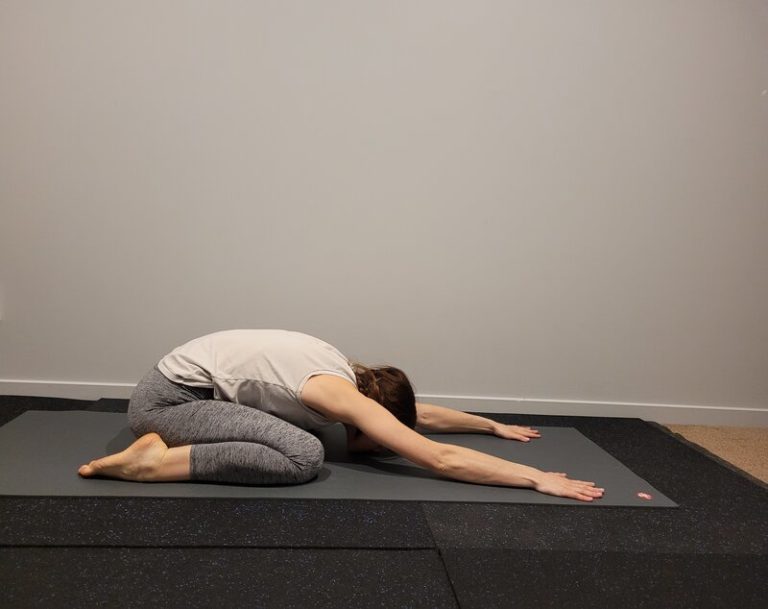
Start to bring your hands forward, while your head is moving down towards the ground. It should feel as though you are trying to push your hips back.[5]
Downward Facing Dog - Adho Mukha Svanasana
Adho = downward, mukha = face, svana = dog
Adho Mukha Svanasana is a full body stretch and possibly the most known yoga asana.
Pressing the palms into the ground and lifting the hips up high lengthens the back, allowing compression in the vertebrae to release.
Adho Mukha Svanasana puts our spine into neutral position
We spend a lot of time curving forward, which can put an extensive amount of compression on the spine, particularly in the cervical and lumbar area.[2,6]
How to do downward facing dog pose
Come onto all fours with your hand slightly forward. Curl the toes, lift the knees of the floor and raise the hips high.
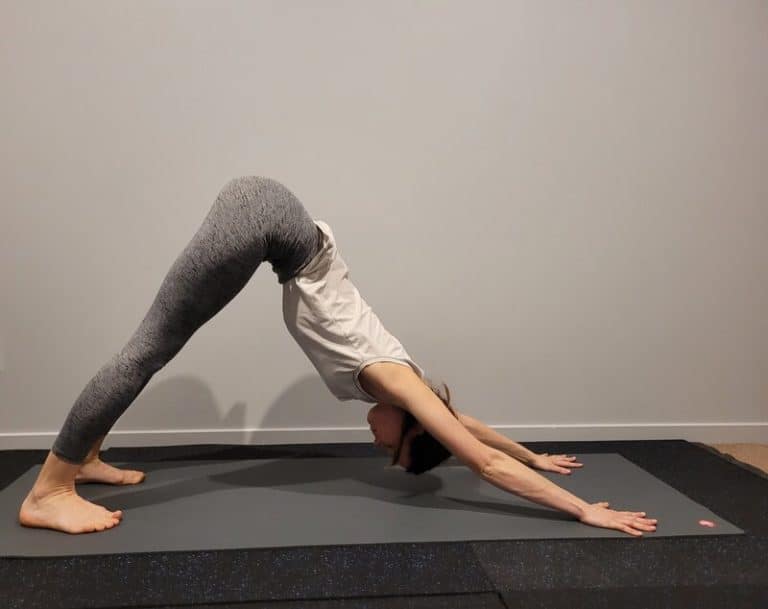
Allow your arms to extend fully, creating a straight line from your wrists to your waist.
Torso stretch - Bharadvajasana
Bharadvaja = An ancient Indian Sage
Twists are particularly powerful in strengthening and providing suppliness to the deepest layer of muscles in our back and neck. They also increase hydration to the discs, preventing degeneration.[7]
Bringing suppliness to the muscles can help to relieve arthritis and reduce any stiffness around the neck.[8]
How to do the torso stretch on a chair
Sit sideways on a chair with your feet flat on the floor, hip distance apart. Turn to face the back of the chair, gripping the back rest with both hands.
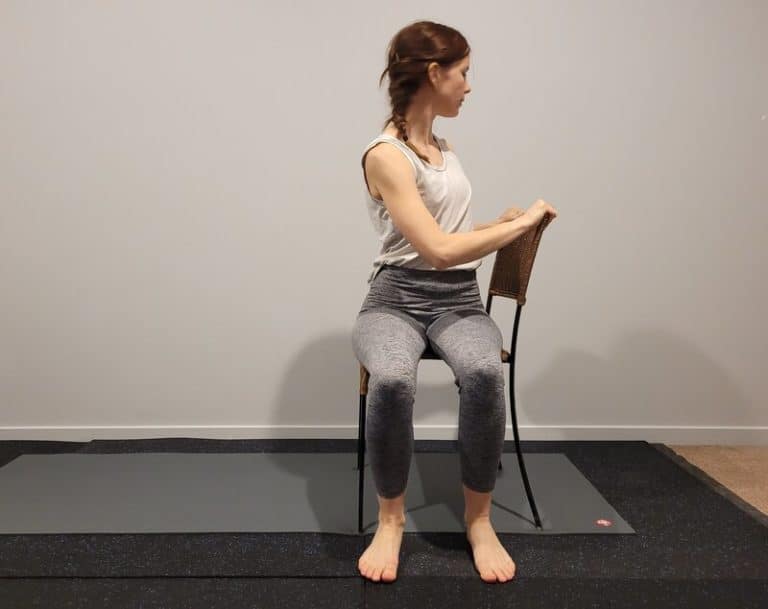
Lift the sternum, roll the shoulders back and lengthen through the neck so that you can extend throughout the whole spine and activate the muscles in the spine.[9]
Mountain - Tadasana
Tada = mountain
Standing incorrectly prevents our weight from being evenly distributed throughout the spine, the back muscles and the hips. This can contribute to impairment in mobility of the spine and muscles.
Standing incorrectly also shifts the center of gravity, making the hips slack, straining the muscles of the back and subsequently making us feel fatigue.
Fatigue then naturally moves us into a slouched position, resulting in more stress in the muscles of the back and the spinal discs.
How to do mountain pose
To bring yourself into correct alignment, stand erect with your feet together. Contract the hips, bring the abdomen in and engage the core.
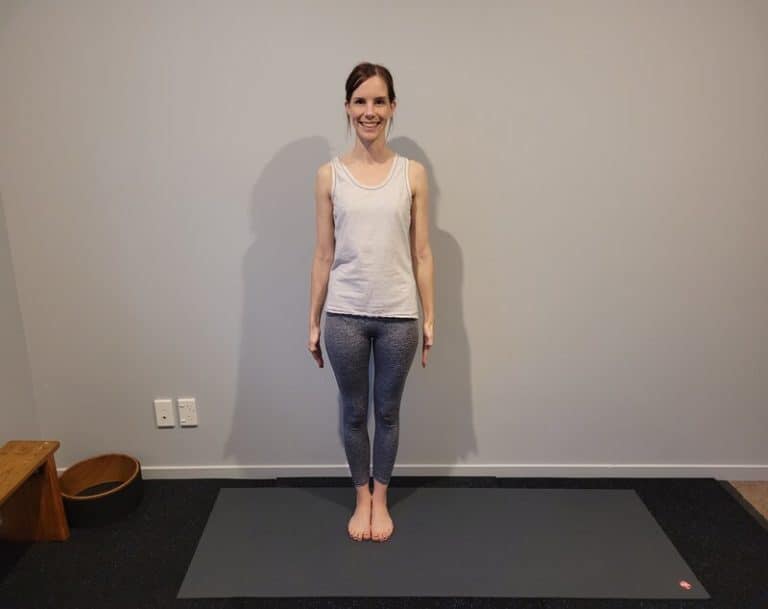
Lift the sternum to allow the spine to come into its neutral position. Distribute the weight evenly through all four corners of the feet.[10]
Summary
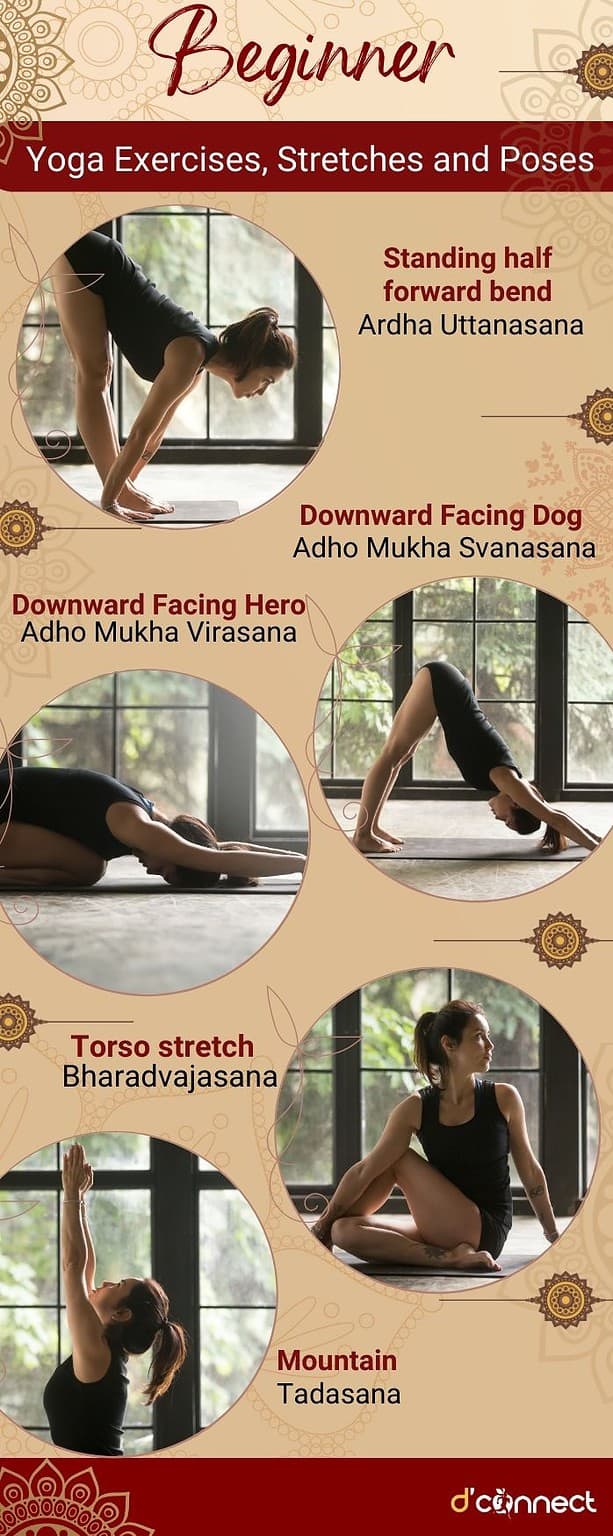
Important note – if this is your first time trying some of these poses, we suggest you focus on the stretch and relax. Give your body time to let go of the stiffness.
Related Questions
1. Is a yoga ball good for exercise, and what exercise can you do with it?
A yoga ball is used to improve balance and muscle strength, and can be used when practicing the yoga asanas to strengthen the muscles, particularly the abdominals muscles.
Balancing on the yoga ball forces the abdominal muscles to activate to keep us upright.[11]
2. Should beginners use yoga blocks?
Yoga props, particularly blocks, make yoga accessible for everyone. The purpose of using props is to create correct alignment and allows us to practice more advanced poses with ease.[12]
3. Can yoga fix a bulging disc?
Yoga is effective in fixing the pain associated with a bulging disc. The asanas help to build the muscles that support the spine and increase joint mobility to prevent stiffness.[13]
If you are currently dealing with a bulging disc I would suggest visiting your local GP or an osteopath.
RELATED — Osteopathy: Natural healing through movement and touch
Have you already tried yoga, or are you just starting? Also, would you have a favorite pose? Let us know in the comments below.
Rachael first started practicing Hatha Yoga in 2014, and since 2017 has been focused on the Iyengar method, where she learned the importance of alignment and precision in asana, and creating yoga as a discipline.
Rachael is passionate about bringing the meaning of yoga and its practice into the community to create freedom from dis-ease in the body and mind. This is why she is continuously improving and evolving as a teacher and is currently in the process of completing CYT 300 teacher training certificate.
References
(1) [YOGABODY]. (2022, June 3). Lower Back Pain? Try These 3 Weird Stretches. YouTube. Retrieved from https://www.youtube.com/watch?v=8IlpIpTC744
(2) Matthews, A. (2011, October 28). Yoga Anatomy (Second). Human Kinetics.
(3) Noon, A.,M. Paraspinal muscle pathophysiology associated with low back pain and spine degenerative disorders. JOR Spine 2021. Retrieved from https://www.ncbi.nlm.nih.gov/pmc/articles/PMC8479522
(4) [Roads To Bliss]. (2014, July 18). Yoga for back pain 2/6 / Ardha Uttanasana with Rosa Santana [Video]. YouTube. Retrieved from https://www.youtube.com/watch?v=gdWp_7RJLqk
(5) [Roads To Bliss]. (2020, July 11). Everything About Adho Mukha Virasana with David Meloni (Iyengar Yoga) [Video]. YouTube.
(6) Brown, C., Anderton-Davies, R., Brown, T. Y. B. B. C., & 978-1582972428, 1. The Classic Yoga Bible. Godsfield Press/Yellow Kite.
(7) Long, R., MD, Ezrin, S., Ezrin, S., Scruggs, A., & Ezrin, S. (2021, September 3). 3 Poses to Relieve Low Back Pain in Twists. Yoga Journal. Retrieved from https://www.yogajournal.com/practice/yoga-sequences/3-poses-relieve-low-back-pain-twists/
(8) Seek Health Z Editorial. (2020, May 16). Bharadvajasana on a Chair (Torso Twist Yoga Pose) – 4 Benefits. SeekHealthZ. Retrieved from https://www.seekhealthz.com/yoga/bharadvajasana-on-a-chair-benefits/
(9) Torso Twist on a Chair – Bharadvajasana. (2022, September 29).
(10) Iyengar, B. K. S. (2006, March 20). Light on Yoga: The Classic Guide to Yoga by the World’s Foremost Author (2/18/06 ed.). Harper Collins Publishers.
(11) Hyde, D. T. C. (n.d.). Exercise Ball Uses. Spine-health.
(12) Iyengar, B. Yoga: THE PATH TO HOLISTIC HEALTH. Dorling Kindersley
(13) Hazlegreaves, S. (2021, October 8). How to treat a herniated disc without surgery. Open Access Government. Retrieved from https://www.openaccessgovernment.org/treat-herniated-disc/64807/

